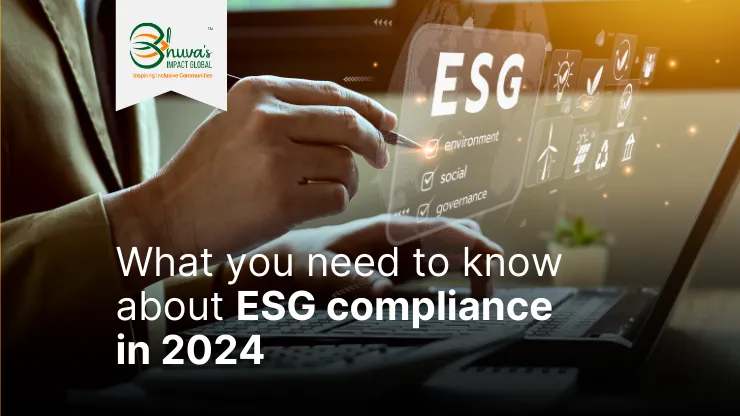Congratulations for starting your ESG journey in 2024!
Ensuring your organization’s compliance with ESG principles is a critical future-proofing step. By doing so, your organization will have a clearer idea where you currently stand and what you need to do to reach your goals and mitigate risk.
Here, you will learn the basics to becoming compliant via a checklist and what you should include in your own ESG compliance checklist.
On the importance of checklists
Dr. Atul Gawande did not invent the use of checklists in medicine. However, his 2009 book, “The Checklist Manifesto,” brought their use to the attention of the general public. Medical doctors are very intelligent people, but they are still human and fallible.
It may seem terribly obvious (and spoiler alert!), but according to Dr. Gawande’s research, physicians who relied on checklists, especially in the emergency room, had greater success at saving patients than those who relied on their memory alone.
Fast forward 15 years later, and checklists are found everywhere in medical settings. This humble tool is not meant to insult the intelligence of highly trained doctors, nurses, and other healthcare professionals but to provide a layer of assurance that procedures are being followed in the proper order. Checklists can also provide a layer of protection to medical professionals against a major form of risk in the healthcare industry, malpractice.
If something as simple as a checklist can save human life and lower the risk of medical errors and potential litigation, imagine what checklists can do for your startup, especially when it comes to ESG compliance.

Why use checklists in ESG compliance
The ultimate goal of using an ESG checklist is to reduce risk.
In the early days of ESG reporting, especially in the case of reporting on environmental impacts, it would be common in most organizations to see a junior employee or an intern skitter from department to department trying to chase down what they needed in order to assess carbon footprint or waste diversion over the course of a week, perhaps two at max.
Electricity, gas, water, and fuel bills paid by finance. Emailing contractors which responsibly dispose of hazardous materials like halogen bulbs, as well as those who pick up recyclables and dispose of municipal solid waste, to learn weights and quantities to plug into a spreadsheet or web application.
This pressurized, asynchronous form data collection was error-prone and could only provide upper management with risk-related information long after the fact.
The message it also sent was that keeping tabs on environmental data was not an organizational priority but an afterthought, a bullet point on the resume of a senior executive to demonstrate their “commitment” to environmental sustainability while walking on the back of some poor underling.
Leadership rolls downhill, and this is precisely the wrong attitude and the wrong atmosphere that an organization should cultivate when it comes to ESG compliance.
ESG compliance should be woven into everyday actions of an organization, and rank and file employees should be cognizant of the requirements and values associated with being ESG compliant. The simplest and most effective way to accomplish the work and integrate ESG methodology into company culture is through checklists.
Benefits for startups to begin an ESG checklist
You may believe your organization is too young and too small to worry about ESG compliance, much less building an ESG checklist. Currently, ESG reporting and compliance is only the law in the European Union, but it’s only a matter of time before it begins to get regulated in the United States.
Participating voluntarily in ESG compliance activities, you can set your company apart in the following ways:
- By being ahead of the curve and prepared for when ESG reporting does become compulsory for your geographic region
- By attracting further investment capital as you have documented what your risks are and your plans to mitigate those risks.

What is included in an ESG checklist (and how to build your own)
Beyond the basics, such as hand washing, changing gloves, taking a patient’s vitals, it would not make sense to necessarily use the same checklist for one adult entering the ER in an ambulance suffering from a gunshot wound in the leg and another about to go into labor. Each scenario is associated with different risks and decisions on these individuals should be made with those risks in mind.
Likewise, in business, even within businesses in the same industry, your ESG checklist may differ from someone else’s and that’s okay.
You want to be measuring data that can provide meaningful information rather than collecting data for the sake of it. Remember: ESG metrics are essential risk metrics, and the fact that you’re reading this article means you understand how important it is to identify risks in business.
Should executing an ESG checklist fall squarely on the shoulders of one employee? Absolutely not. An ESG checklist is meant to explore three areas: environmental impact, societal impacts, and governance. Accordingly, a team of people with expertise in these three areas within your company or a group of independent auditors, should be involved in accumulating the data for these domains.
The market is saturated with software developers who have offerings for various industries. Alternatively, checklists can be built from scratch if you have the coding expertise available on staff. If you are just starting out, your checklist can be quite simple to get you going.
The section dedicated to environmental risk should contain questions related to energy usage, pollution generation, waste disposal and the like.
In examining risks related to social impacts, demographic information on the employee base or the clientele being served by your startup would be requested. For risks within the governance dimension, information on executive pay and the demographic information of any boards associated with your company would be present.
How do I execute an ESG checklist?
An ESG checklist is part and parcel of a wider process known as an ESG audit, which can be done in house or with the assistance of an independent auditing firm.
As you are beginning your ESG journey, working through a checklist in house is still a useful first step. And it is really as simple as answering the queries for each category. From this baseline data, you discover areas for improvement, which can then be worked into your daily operations strategy.
Did you know? ESG is becoming increasingly important in the United States. If your tech startup is based outside of the USA, but are thinking of expanding into the American market, we’ve got a PDF of checklists that will help you get started.
Download the Essential Tech Startup Guide
How a fractional COO can help
A Fractional COO can assist in the following ways to help prepare an ESG checklist.
- If you have not already done so, a Fractional COO can help guide you to the ESG framework and standard which is most appropriate for your business
- A Fractional COO can also provide guidance on whether to choose a ready-made, off-the-shelf software product or to have a solution developed from scratch that is fully customized for your enterprise.
- Should you feel ready to engage in a third party review of your ESG compliance, a Fractional COO can assist with selecting an auditing firm.
Most importantly, once your organization has collected its baseline data, a Fractional COO works to fine tune your ESG strategy in order to boost performance, increase profitability, while lowering the chances of negative impacts on the environment, society at large, and your internal governance mechanisms.
How Bhuva’s Impact Global can help you with your ESG checklist

With decades of experience and an international portfolio across a swath of industries, you can trust Bhuva’s Impact Global to guide your startup through its ESG journey.
2024 will be gone before we know it. Make it your year to develop an ESG checklist as part of a comprehensive ESG strategy. Contact Bhuva for a consultation to learn more today!


